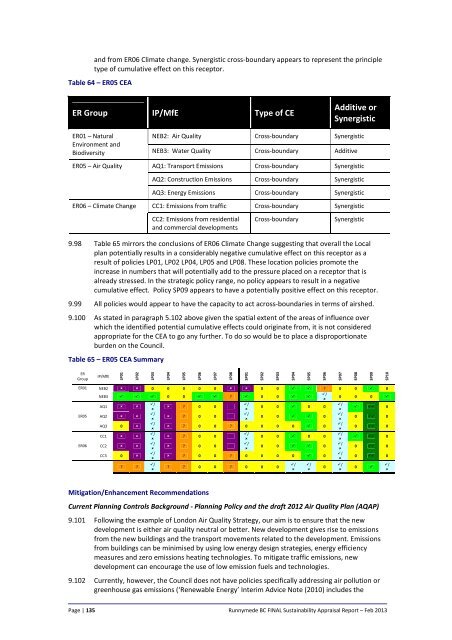DRAFT Sustainability Appraisal Report for the Emerging Local Plan ...
DRAFT Sustainability Appraisal Report for the Emerging Local Plan ...
DRAFT Sustainability Appraisal Report for the Emerging Local Plan ...
Create successful ePaper yourself
Turn your PDF publications into a flip-book with our unique Google optimized e-Paper software.
and from ER06 Climate change. Synergistic cross‐boundary appears to represent <strong>the</strong> principle<br />
type of cumulative effect on this receptor.<br />
Table 64 – ER05 CEA<br />
ER Group IP/MfE Type of CE<br />
Additive or<br />
Synergistic<br />
ER01 – Natural<br />
NEB2: Air Quality Cross‐boundary Synergistic<br />
Environment and<br />
Biodiversity NEB3: Water Quality Cross‐boundary Additive<br />
ER05 – Air Quality<br />
ER06 – Climate Change<br />
AQ1: Transport Emissions Cross‐boundary Synergistic<br />
AQ2: Construction Emissions Cross‐boundary Synergistic<br />
AQ3: Energy Emissions Cross‐boundary Synergistic<br />
CC1: Emissions from traffic Cross‐boundary Synergistic<br />
CC2: Emissions from residential<br />
and commercial developments<br />
Cross‐boundary<br />
Synergistic<br />
9.98 Table 65 mirrors <strong>the</strong> conclusions of ER06 Climate Change suggesting that overall <strong>the</strong> <strong>Local</strong><br />
plan potentially results in a considerably negative cumulative effect on this receptor as a<br />
result of policies LP01, LP02 LP04, LP05 and LP08. These location policies promote <strong>the</strong><br />
increase in numbers that will potentially add to <strong>the</strong> pressure placed on a receptor that is<br />
already stressed. In <strong>the</strong> strategic policy range, no policy appears to result in a negative<br />
cumulative effect. Policy SP09 appears to have a potentially positive effect on this receptor.<br />
9.99 All policies would appear to have <strong>the</strong> capacity to act across‐boundaries in terms of airshed.<br />
9.100 As stated in paragraph 5.102 above given <strong>the</strong> spatial extent of <strong>the</strong> areas of influence over<br />
which <strong>the</strong> identified potential cumulative effects could originate from, it is not considered<br />
appropriate <strong>for</strong> <strong>the</strong> CEA to go any fur<strong>the</strong>r. To do so would be to place a disproportionate<br />
burden on <strong>the</strong> Council.<br />
Table 65 – ER05 CEA Summary<br />
ER<br />
Group<br />
IP/MfE<br />
LP01<br />
LP02<br />
LP03<br />
LP04<br />
LP05<br />
LP06<br />
LP07<br />
LP08<br />
SP01<br />
SP02<br />
SP03<br />
SP04<br />
SP05<br />
SP06<br />
SP07<br />
SP08<br />
SP09<br />
SP10<br />
ER01<br />
ER05<br />
ER06<br />
NEB2 0 0 0 0 0 0 0 ? 0 0 0<br />
NEB3 0 0 ? 0 0 <br />
/<br />
<br />
0 0 0 <br />
AQ1 <br />
/<br />
/<br />
/<br />
? 0 0<br />
0 0 0 0<br />
<br />
<br />
<br />
0<br />
AQ2 <br />
/<br />
/<br />
/<br />
? 0 0<br />
0 0 0<br />
<br />
<br />
<br />
0 0<br />
AQ3 0 <br />
/<br />
/<br />
? 0 0 ? 0 0 0 0 0<br />
<br />
<br />
0 0<br />
CC1 <br />
/<br />
/<br />
/<br />
? 0 0<br />
0 0 0 0<br />
<br />
<br />
<br />
0<br />
CC2 <br />
/<br />
/<br />
/<br />
? 0 0<br />
0 0 0<br />
<br />
<br />
<br />
0 0<br />
CC3 0 <br />
/<br />
/<br />
? 0 0 ? 0 0 0 0 0<br />
<br />
<br />
0 0<br />
? ?<br />
/<br />
<br />
? ? 0 0 ? 0 0 0<br />
/<br />
<br />
/<br />
<br />
0<br />
/<br />
<br />
0 <br />
/<br />
<br />
Mitigation/Enhancement Recommendations<br />
Current <strong>Plan</strong>ning Controls Background ‐ <strong>Plan</strong>ning Policy and <strong>the</strong> draft 2012 Air Quality <strong>Plan</strong> (AQAP)<br />
9.101 Following <strong>the</strong> example of London Air Quality Strategy, our aim is to ensure that <strong>the</strong> new<br />
development is ei<strong>the</strong>r air quality neutral or better. New development gives rise to emissions<br />
from <strong>the</strong> new buildings and <strong>the</strong> transport movements related to <strong>the</strong> development. Emissions<br />
from buildings can be minimised by using low energy design strategies, energy efficiency<br />
measures and zero emissions heating technologies. To mitigate traffic emissions, new<br />
development can encourage <strong>the</strong> use of low emission fuels and technologies.<br />
9.102 Currently, however, <strong>the</strong> Council does not have policies specifically addressing air pollution or<br />
greenhouse gas emissions (‘Renewable Energy’ Interim Advice Note (2010) includes <strong>the</strong><br />
Page | 135 Runnymede BC FINAL <strong>Sustainability</strong> <strong>Appraisal</strong> <strong>Report</strong> – Feb 2013

















